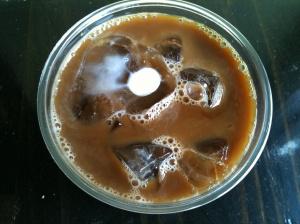The Japanese have been creating a market for cold coffee for a few decades, mainly in cans. Needless to say, they are not the only ones today. Also the Greek made their contribution to the world of cold coffee in the 60′s with the Frappe, the Italian with the wonderful mixture of coffee and vanilla ice cream and in Puerto Rico the “piraguas” could be seen everywhere, where huge blocks of ice are carried in small street carts and scrapped. The scrapped ice is put into a paper cone and covered with a variety of sirups. One of these might be coffee. In a similar manner, but in what is usually known as “slush”, in Israel is the frozen version the most common one and often flavoured – the ‘slushie’.
In main land Europe and in the North Americas, however, the main product around this time seems to be the increasingly popular iced coffee, some obtained from cold coffee brews which rely on time, others from the usual methods rely on heat. What seems to be a very new trend, is not at all. As early as in the 19th century, some forms of iced coffee have been served in Australia.
In Chile it is popular to drink “cafe helado” (frozen coffee), based mainly on the mixtures of espresso or coffee powder, with sugar, vanilla, chocolate and sweet milk, as well as with different nuts. In India, just like in Greece and Cyprus with their Frappe, the iced coffee is commonly prepared with instant coffee.
In New York City it is kept very simple, but it is extremely popular. Some from a cold brew, others from a hot brew turned cold, the coffee is served in its simplest cold form and seen throughout the city. Even I have had a few of them and this one in particular – with my usually desired bit of milk – gave a beautiful picture of drinkable coffee, as opposed to my many undrinkable coffee rests.

Iced coffee with unusual milk spot

